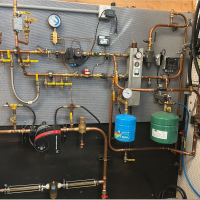Need a tech for HTP EL-110 boiler in Bay Area

Comments
-
hi everyone,
I have an htp el-110 boiler.
I’m looking for a Bay Area certified tech that can do a combustion analysis and make adjustments to my boiler.
1.) I’m having trouble finding such a person. Does anyone here know of someone in the Bay Area?2.) The manual has information for a tech about the throttle adjustment and what it does when you turn it counter clockwise or clockwise but it has 0 information about the offset.
Does anyone know what turning the offset adjustment clockwise and counter clockwise does? Ie. Which direction increases CO2 making it richer? I would like to share this information with whoever I find, in case they have to adjust this part, I understand they need to be careful with this adjustment.
0 -
@pponcedeleon, I've created a new discussion for you here so that your comment doesn't get lost at the bottom of an older thread.
Forum Moderator
1 -
I’m sorry that I can help with a recommendation for a tech, but you don’t wanna touch that throttle screw unless you’re a trained professional with a combustion analyzer.
Try finding the local distributor for HTP and ask if they can recommend someone.
Bob Boan
You can choose to do what you want, but you cannot choose the consequences.0 -
-
Sorry for the long delay here. Been out of town.
Thanks for moving the thread @Ironman and thanks for providing contact info @Alan (California Radiant) Forbes .
I’ve been doing a lot of learning and troubleshooting of my radiant heat system with indirect water tank for DHW.
Found a few issues and have rectified some that I could do myself and have mitigated others for now. None related to messing with the gas throttle or offset adjustment.
I initially wanted a tech out who was certified to do combustion analyses because there were some noises that I thought were “light explosions” but I now realize are actual slight water hammer noises. Still an issue but I think less of a problem if i were to rank against combustion explosions.I figured out it was a water hammer by observing (with always on video camera) exactly when the noise would happen.
I noticed the noise would happen only exactly when the pre purge fan would kick in BEFORE ignition. I still thought ok maybe this is some gas left over, maybe faulty gas valve. But I also noticed that sometimes it would happen when DHW priority would kick in during a CH call for heat. And in this case there was no pre purge fan. It went from a live already ignited fire CH active situation to DHW. I’d hear the click for the pump change from CH pump to DHW pump and the sound would happen. I also noticed my system pressure drop from 13 to about 11 and then come back to 13 when the sound would happen. That confirmed to me the noise was a pump change pressure situation. My expansion tank is not in an ideal location in my system. It’s a bit far away from the boiler. I suspect that is the issue here. Likely not able to accommodate the impact here.
@alan I have some other issues I’d like to resolve as well so I might give you a call.Run down of what I’ve painstakingly figured out through lots of reading and observations and learning.
1.) I had a leak in my safety pressure relief valve. I replaced it with an equivalent one. That problem fixed.2.) I realized that my pressure regulating valve (the one that is supposed to keep my radiant loop system pressure at 12 psi was no longer working as designed. It was allowing slow amounts of water through. Causing pressure to rise to closer to 22-25 psi levels. Now that I’ve got all leaks under control I’ve just shut off the water to the system. So that it’s basically not being used right now. System is stable at 13 psi (hot) 12 psi when cold. I did buy a replacement regulating valve. I just don’t think I want to do this one myself. Though I do have everything I need to sweat some pipe because i did do the pressure relief valve swap.
3.) Taco Vortech air separator was leaking from the air vent. I was able to open the air vent. Clean the inside well and tighten it back on well. No leaks now! So good here.
4.) I have two taco 5003-c2 mixing valves. They both started to leak slightly from the knob used to set the mixing temperature output. A small leak but leak none the less. I was able to stop the leak and it has held for a few months now. Still going strong. My solution was to unscrew the knob all the way apply some grease to the screw and screw it back in all the way then back out to the temp I wanted it to output at. In both cases the leak stopped and it has been good for 3 months and counting. I want to swap these out but taco no longer makes the c2 variant and the c3 is slight different dimensions. Hate that! So it might not be just an easy swap but might involve cutting some copper a bit to fit the new one. I’d rather not do this myself.
5.) I could benefit from a radiant heat pex tubing flush. I see some dirt in the glass things that are on the manifold where the pex tubes come in and out of. I could probably do this myself. I think my system got dirty despite being a closed loop system because of all the leaks I had and also I had a nail in one of my pex pipes that ended up bursting. I got that fixed but I think the nail contributed to rust and air in the system over time. So that lead to what looks like dirt in the pex manifold. The pex is fixed and so now the system is tight and stable with all my other fixes up above.
That was all long winded. Sorry about that. But that’s been my journey into plumbing and HVAC. It’s been fascinating. And I respect everyone who truly tries to troubleshoot these systems!@alan I may give you a call if you are open to help with 2, 4 and maybe 5 above. Would also like some suggestions on how to mitigate the water hammer that I have when the pump switches from CH to DHW pumps. Maybe a I can add a delayed relay switch to the DHW pump line? Maybe a combustion analysis too for good measure.
0 -
why the mixing valves if you have a low temperature boiler?
Are there high temperature zones also?
Bob "hot rod" Rohr
trainer for Caleffi NA
Living the hydronic dream0 -
good question. I’m not 100% sure.
There is an indirect water tank that I have set to 140. I have a third taco mixing valve that brings the actual DHW down to 120 from there.
Then there are two radiant in floor heating zones. Each one has a taco mixing valve. There used to be a different boiler hooked up to this system. A munchkin something. I’ve had this htp el-110 connected for like 14 years though. I think it’s over sized for my home. I’ve got it set at 50% boiler output which handles my DHW and Ch needs fine here in San Francisco.
There are probably other things that are not ideal about the way it’s all piped and configured. I’m forgetting where exactly, but there is a section in the manual that says there should be a “max 4 pipe diameter” section of copper pipe in a specific spot. And there is definitely much more than 4 pipe diameter in my system. Like 10x more. So I’m sure there are other quirks here. But it does work for my family of 4. Keeps us warm and keeps hot water flowing when ever we’ve needed it.0 -
it would be worth having Alan do a drive by and see what you have. He knows radiant well.
And is a fun guy to chat with, local color.
Bob "hot rod" Rohr
trainer for Caleffi NA
Living the hydronic dream0 -
Color me purple.
Even with a Munchkin, you shouldn’t have needed those mixing valves. You might consider getting rid of them as your boiler would be more efficient running at lower temps for the radiant. And your boiler knows the difference between a heating call and a call for DHW and ramps up the temp. for the latter.
Is there an outdoor sensor connected to the boiler?
And no need to flush your system as those little flow meters often discolor. I have a bunch of Rehau flow meters for free if that’s your brand. New water has oxygen which is not good for your system.
8.33 lbs./gal. x 60 min./hr. x 20°ΔT = 10,000 BTU's/hour
Two btu per sq ft for degree difference for a slab0 -
There is a working outdoor sensor. I have CH set so that when it’s 40 degrees outside the CH set point is 140. Mixing valves then lower that. When it’s 74 outside it’s set to 120. I can probably lower that. But my cut off weather temp is set to 68. So there should be no calls for Ch when it hits 68.
Yeah those mixing valves I think prefer greater than 120 temps is what I’ve read.
Here are some pics of my system. I do think that in my case it might be worth a flush of the downstairs radiant pex run.I’ve had issue with some leaks as per my write up for some time. And the pressure regulator letting in fresh water due to leaks and also malfunctioning, looks like real junk build up.
Here are some pictures. Maybe before the munchkin there was a different boiler. And they just reused most of the system piping? That’s basically what they did when the put in the HtP and replaced the munchkin. So maybe it was designed for a different setup altogether. It does work. Maybe not efficient. And I definitely like to get rid of the water hammer.
0 -
The piping looks fine except there's no insulation.
Time to change the neutralizer pellets? I recommend every 2-3 years. Nice that they put a union in for servicing; better if they put one on the other side; just can't see it as it's out of the picture.
The mixing valves on a radiant system with a mod/con boiler is not the end of the world. Just more maintenance with the mixing valves and a scootch less efficient. Your boiler will still condense, just not as much.
8.33 lbs./gal. x 60 min./hr. x 20°ΔT = 10,000 BTU's/hour
Two btu per sq ft for degree difference for a slab0 -
I recently changed the pellets. Like a few weeks ago. I asked them to put that union in years ago so I could do it, It looks dirty cause it was hard to clean out originally when I first moved in and started to maintain it myself. There is no union on the other side but it is easy to remove with just the one.
The main concern with the mixing valves that I have is that they did start to leak. Maybe all it needs is to be opened up and cleaned and regreased. I added some grease on the adjustment knob threads to stop the leaks. Seems to have worked for now.The nice things about the mixing valve is that I can adjust the temp for downs stairs where the pex is in cement vs upstairs where it’s under wood floor. So while less efficient overall I do have some control.
0 -
@Alan (California Radiant) Forbes what would you suggest for my water hammer problem?
the expansion tank is working. I have set the psi to 12 psi pre charge (let system cool and lowered pressure to 0). Then set the charge. It holds air.Even though it holds air. Could it be that it needs replacement? Like the membrane is too stretched out or something.
I was thinking to install an inline delay relay on my DHW pump to have it delay start 1 second after CH pump. but maybe there are better ways to deal with it.
0 -
-
It turns out the water hammer was due to an air pocket. While i was trying to check and adjust the expansion tank pre-charge psi level, the air pocket must have worked its way through.
no more loud noises at night and during the day!0
Categories
- All Categories
- 87.3K THE MAIN WALL
- 3.2K A-C, Heat Pumps & Refrigeration
- 61 Biomass
- 429 Carbon Monoxide Awareness
- 120 Chimneys & Flues
- 2.1K Domestic Hot Water
- 5.8K Gas Heating
- 114 Geothermal
- 166 Indoor-Air Quality
- 3.7K Oil Heating
- 77 Pipe Deterioration
- 1K Plumbing
- 6.5K Radiant Heating
- 395 Solar
- 15.7K Strictly Steam
- 3.4K Thermostats and Controls
- 56 Water Quality
- 51 Industry Classes
- 50 Job Opportunities
- 18 Recall Announcements






